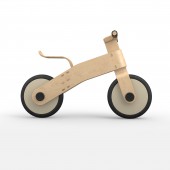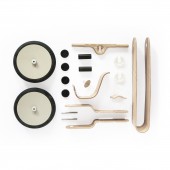
| THE AWARD |
| CATEGORIES |
| REGISTRATION |
| SUBMIT YOUR WORK |
| ENTRY INSTRUCTIONS |
| TERMS & CONDITIONS |
| PUBLICATIONS |
| DATES & FEES |
| METHODOLOGY |
| CONTACT |
| WINNERS |
| PRESS ROOM |
| GET INVOLVED |
| DESIGN PRIZE |
| DESIGN STORE |
| THE AWARD | JURY | CATEGORIES | REGISTRATION | PRESS | WINNERS | PUBLICATIONS | ENTRY INSTRUCTIONS |
Choppy Wooden Balance Bike For Kids by Aldis Blicsons |
Home > Winners > Design #131024 >Interview |
 |
|
FS: What is the main principle, idea and inspiration behind your design?
AB: Balance bike Choppy is the second product of an enthusiastic and friendly design and engineering team. After the success of our first balance bike - the award-winning Brum Brum Bike - we took up the challenge of making our next bike lighter, more nature-friendly, comfortable, and better suited for kids up to 4 years of age.
FS: What has been your main focus in designing this work? Especially what did you want to achieve?
AB: To build this bike as eco-friendly as possible. Less metal (no metal screws or bearings), tool-less assembling and 2nd life for packaging.
FS: What are your future plans for this award winning design?
AB: We are now approaching the point when Choppy will begin commercial production and set off to conquer the world.
FS: How long did it take you to design this particular concept?
AB: First sketches came out in 2017. Industrial prototyping ended just in 2021.
FS: Why did you design this particular concept? Was this design commissioned or did you decide to pursuit an inspiration?
AB: We just had an idea to create a balance bike for kids without any screws and it all began by itself.
FS: Is your design being produced or used by another company, or do you plan to sell or lease the production rights or do you intent to produce your work yourself?
AB: All parts are produced, packed and sent out by outsource companies. We have a back office to manage it.
FS: What made you design this particular type of work?
AB: We have huge knowledge of how to design and produce a wooden balance bike for kids and this was the next step with better solutions.
FS: Where there any other designs and/or designers that helped the influence the design of your work?
AB: Predecessor wooden balance bikes for kids and some unrealistic design concepts from several designers.
FS: Who is the target customer for his design?
AB: Choppy is the perfect first bike for 1-4 year-olds. Main customers are parents who care about sustainability and are eco-friendly minded.
FS: What sets this design apart from other similar or resembling concepts?
AB: Choppy is probably the lightest wooden balance bike for kids in the world. It can be assembled as a construction game or building blocks without using any tools. Its packaging box has a board game printed on it, making Choppy even more fun.
FS: How did you come up with the name for this design? What does it mean?
AB: It looks like chopper motorcycle on lowest position of assembly for the smallest drivers. We made the word "Chopper" more playful.
FS: Which design tools did you use when you were working on this project?
AB: Everything happens in my head and I use paper or software just to understand, if it works or not.
FS: What is the most unique aspect of your design?
AB: The balance bike features an innovative design without a single screw. Any adult can assemble the Choppy bike and adjust its height without using any tools.
FS: Who did you collaborate with for this design? Did you work with people with technical / specialized skills?
AB: We worked together with Riga Technical University Science and Innovation Center on prototyping and best material research. Industrial prototyping happened in factories where we are producing the bike - Daiļrade koks (wood), Rumba-V (plastic) and Stora Enso (packaging).
FS: What is the role of technology in this particular design?
AB: Knowledge about plywood bending techologies and possibility of machines being able to cut out very precise details had a big role. Special type of polymers helped use plastic bearings instead of metal and made tubeless tires of wheels.
FS: Is your design influenced by data or analytical research in any way? What kind of research did you conduct for making this design?
AB: We collected all the measurements and weights of our friends toddlers to calculate the correct shape of bike.
FS: What are some of the challenges you faced during the design/realization of your concept?
AB: Industrial prototyping. Every single change took months. There are big machines with big forms that you need disassemble, change shape of the form and then assemble. Then try again.
FS: How did you decide to submit your design to an international design competition?
AB: We had many awards with our first product - Brum Brum bike. Submission of Choppy bike to the competition was logical.
FS: What did you learn or how did you improve yourself during the designing of this work?
AB: Design studio STUM was born during this process. Now we have a place to design, prototype and have fun.
FS: Any other things you would like to cover that have not been covered in these questions?
AB: No.
FS: Thank you for providing us with this opportunity to interview you.
A' Design Award and Competitions grants rights to press members and bloggers to use parts of this interview. This interview is provided as it is; DesignPRWire and A' Design Award and Competitions cannot be held responsible for the answers given by participating designers.
| SOCIAL |
| + Add to Likes / Favorites | Send to My Email | Comment | View Press-Release | Translations |





